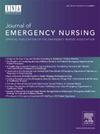A Novel Streamlined Triphasic Approach to Training Pediatric Emergency Staff for Ultrasound-Guided Peripheral Intravenous Access
IF 2.3
4区 医学
Q2 EMERGENCY MEDICINE
引用次数: 0
Abstract
Introduction
Ultrasound-guided peripheral intravenous access enhances the clinical management of pediatric patients with difficult intravenous access. However, the quality and depth of the training required to master this skill can vary significantly. We instituted a novel curriculum to streamline the training process using a simplified 3-phase approach.
Methods
This prospective observational study included emergency nurses and paramedics trained in ultrasound-guided peripheral intravenous placement from October 2020 to November 2021. Pediatric emergency nurses and paramedics with experience and proficiency in standard peripheral intravenous placement were included. The training curriculum included 3 phases: (1) 3 hours of didactics, machine, and phantom training; (2) at least 10 supervised cannulations; and (3) 10 unsupervised cannulations in patients with difficult intravenous access. Participants were assessed at each phase and 6 months after the initial training.
Results
Thirty participants completed the training. The average years of experience was 6.37 years (standard error of mean 1.17). Likert rating of comfort level with ultrasound machine competency, vascular anatomy, image acquisition, interpretation, and clinical integration respectively increased significantly between the pretraining survey and post-training survey [2.83 (0.29) vs 4.07 (0.12); 2.83 (0.29) vs 4.30 (0.12); 2.33 (0.23) vs 4.22 (0.13); and 3.00 (0.34) vs 4.22 (0.18); P < .05]. This was sustained for more than 6 months after training. We observed a concomitant decrease in peripheral intravenous attempts (standard 2.86 ± 0.22 vs ultrasound-guided peripheral intravenous 1.2 ± 0.08). The training was valuable (4.9 ± 0.05) and changed clinical management (4.5 ± 0.20) of patients with difficult intravenous access.
Discussion
These findings support the integration of ultrasound-guided peripheral intravenous access as part of staff training to enhance pediatric emergency nurses’ paramedic cannulation skills and improve patient management.
一种新型流线型三段式超声引导外周静脉通路儿科急救人员培训方法。
导读:超声引导下的外周静脉通路提高了儿科静脉通路困难患者的临床管理水平。然而,掌握这项技能所需的训练的质量和深度可能会有很大差异。我们制定了一个新的课程,以简化的三个阶段的方法来简化培训过程。方法:本前瞻性观察研究纳入了2020年10月至2021年11月接受超声引导外周静脉置入术培训的急诊护士和护理人员。有经验和熟练掌握标准外周静脉滴注的儿科急诊护士和护理人员被纳入研究对象。培训课程包括三个阶段:(1)3小时的教学、机器和模拟训练;(二)至少10个监督插管;(3)静脉进入困难患者无监护插管10次。在每个阶段和初始训练后6个月对参与者进行评估。结果:30名参与者完成了培训。平均工作年限为6.37年(平均标准误差为1.17)。在超声机器能力、血管解剖、图像采集、解释和临床整合方面的Likert舒适度评分在训练前调查和训练后调查中分别显著提高[2.83(0.29)比4.07 (0.12)];2.83 (0.29) vs 4.30 (0.12);2.33 (0.23) vs 4.22 (0.13);3.00 (0.34) vs 4.22 (0.18);讨论:这些研究结果支持将超声引导下的外周静脉通路作为员工培训的一部分,以提高儿科急诊护士的护理插管技能并改善患者管理。
本文章由计算机程序翻译,如有差异,请以英文原文为准。
求助全文
约1分钟内获得全文
求助全文
来源期刊
CiteScore
3.10
自引率
11.80%
发文量
132
审稿时长
46 days
期刊介绍:
The Journal of Emergency Nursing, the official journal of the Emergency Nurses Association (ENA), is committed to the dissemination of high quality, peer-reviewed manuscripts relevant to all areas of emergency nursing practice across the lifespan. Journal content includes clinical topics, integrative or systematic literature reviews, research, and practice improvement initiatives that provide emergency nurses globally with implications for translation of new knowledge into practice.
The Journal also includes focused sections such as case studies, pharmacology/toxicology, injury prevention, trauma, triage, quality and safety, pediatrics and geriatrics.
The Journal aims to mirror the goal of ENA to promote: community, governance and leadership, knowledge, quality and safety, and advocacy.

 求助内容:
求助内容: 应助结果提醒方式:
应助结果提醒方式:


